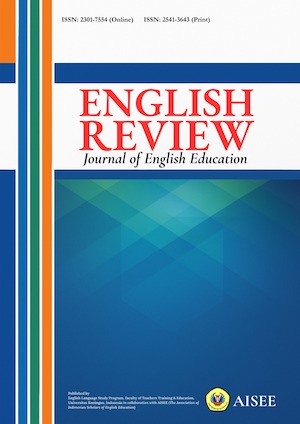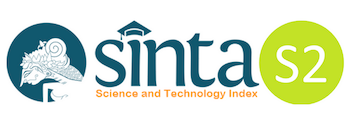PISA READING LITERACY: ENCOUNTERING FEMALE AND MALE’ READING LITERACY ABILITY
Abstract
Much research sounds that male students’ reading competency is lower than females’. This article, then, uncovers the cognitive processes of male and female students seen from the sample questions in the 2018 PISA. This descriptive research involved fifteen male and sixteen female students. They were tested to answer PISA sample test consisting 21 items. It was found that the students score in reading literacy is poor. The highest score was 76; the lowest score was 10; the average score was 31. The result proved that female students are better in reading literacy than males are. Among eight cognitive process, female students are good at accessing and retrieving information, integrating and generating inferences across multiple sources, assessing quality and credibility, reflecting on content and form, and detecting and handling conflict. While, male students are better in integrating and generating inferences. The implication of the research is the teachers should provide HOTS instructional methods.
References
Alderson, J. C. (2003). Assessing Reading. Cambridge: Cambridge University Press.
Thahir, A. (2018). Psikologi Perkembangan. Lampung: Aura Publishing.
Bijou, M., & Mariem, L. (2018). Gender and students’ achievements: evidence from PISA 2015. World Journal of Education, 8(4), 24-35. doi:10.5430/wje.v8n4p24
Di Castro, G., & Ferri, V. (2022). Why do boys perform worse than girls in reading literacy? evidences from PISA survey 2018. https://oa.inapp.org/bitstream/handle/20.500.12916/3427/INAPP_DiCastro_Ferri_Why_do_boys_perform_worse_than_girls_in_reading_literacy_evidences_from_PISA_survey.pdf?sequence=1 doi: https://doi.org/10.33200/ijcer.919958
Ertem, H. Y. (2021). Examination of Turkey’s PISA 2018 reading literacy scores within student-level and school-level variables. ParticipatoryEducationalResearch, 8(1),248-264. doi:http://dx.doi.org/10.17275/per.21.14.8.1
Harju-Luukkainen, H., Vettenranta, J., Ouakrim-Soivio, N., & Bernelius, V. (2016). Differences between students’ PISA reading literacy scores and grading for mother tongue and literature at school: A geostatistical analysis of the Finnish PISA 2009 data. Education Inquiry, 7(4), 463-479 doi:10.3402/edui.v7.29413
Harsiati, T and Priyatni, E.T. (2018). The characteristics of literacy test items in PISA. Litera, 17(1), 1-11
Harsiati, T. (2018). Karakteristik soal literasi membaca pada program PISA. Jurnal Penelitian Bahasa, Sastra dan Pengajarannya, 17(1), 90-106.
Isci, C. (2021). Reading literacy of bilingual and monolingual students in Turkey: a comparative study based on PISA 2018 data. Netjournals, 9(1), 22-28. doi:DOI: 10.30918/AERJ.9S1.21.010
Jerrim, J., & Wyness, G. (2016). Benchmarking London in the PISA rankings. London Review of Education, 14(2), 38-65. doi:DOI: 10.18546/LRE.14.2.04
Khorramdel, L., Pokropek, A., Joo, S. H., Kirsch, I., & Halderman, L. (2020). Examining gender DIF and gender differences in the PISA 2018 reading literacy scale: A partial invariance approach. Psychological Test and Assessment Modeling, 62(2), 179-231.
Kogar, N. O. (2021). An investigation of the mediating role of various variables in the effect of both gender and economic, social and cultural status on reading literacy. International Journal of Progressive Education, 17(1), 376-391.
Koyuncu, I., & Firat, T. (2020). Investigating reading literacy in PISA 2018 assessment. International Electronic Journal of Elementary Education, 13(2), 263-275. doi:10.26822/iejee.2021.189
Malawi, I, Tryanasari, D, and Kartikasari, A. (2017). Pembelajaran Literasi Berbasis Sastra Lokal. Magetan. CV. AE. Medika Grafika.
OECD. (2016). PISA 2015 Assessment and Analytical Framework: Science, Reading, Mathematic and Financial Literacy. PISA, OECD Publishing, Paris, DOI: http://dx.doi.org/10.1787/9789264255425-en
OECD. (2009). PISA 2009 assessment framework – key competencies in reading, mathematics and science. Retrieved from https://www.oecd.org/pisa/pisaproducts/44455820.pdf
OECD. 2006). Framework Program International Students Assessment. Paris: OECD.
OECD. 2017. PISA for Development Assessment and Analytical Framework: Reading, Mathematics and Science. Preliminary Version, OECD Publishing, Paris.
OECD. 2019. “What is PISA?”, in PISA 2018 Assessment and Analytical Framework. OECD Publishing, Paris, doi: https://doi.org/10.1787/2c7c311d-e
OECD/UNESCO-UIS 2. (2003). Program for International Student Assessment and Non-OECD Assessment and Non-OECD Countries. Retrieved from https://www.oecd.org/berlin/42174841.pdf
Ömür, Ç. (2020). Relationships between students' socioeconomic status, parental support, students' hindering, teachers' hindering and students' literacy scores: PISA 2018. World Journal of Education, 10(4), 45-59. doi: https://doi.org/10.5430/wje.v10n4p45
PISA. (2018). Released FT and MS Reading Literacy Items. Retrieved from https://www.oecd.org/pisa/test/PISA2018_Released_REA_Items_12112019.pdf
Primi, C., Donati, M. A., Chiesi, F., & Morsanyi, K. (2018). Are these gender differences in cognitive reflection? Invariance and diffeences related to mathematics. Thinking & Reasoning, 24(2), 258-279.
Pulkkinen, J., & Rautopuro, J. (2022). The correspondence between PISA performance and school achievement in Finland. International Journal of Educational Research, 114(2022). 1-9
Ramli, M., Susanti, B. H., Yohana, M. P., & Rozak, A. (2021, March). Assessing Islamic junior high school students’ scientific literacy using PISA released items. In Journal of Physics: Conference Series, 1836(1). IOP Publishing. doi:10.1088/1742-6596/1836/1/012068
Rosa, F. O. (2017). Eksplorasi kemampuan kognitif siswa terhadap kemampuan memprediksi, mengobservasi dan menjelaskan ditinjau dari gender. Jurnal Pendidikan Fisika, 5(2), 111-118.
Sujiono, Y. N. (2015). Metode Pengembangan Kognitif. Jakarta: Universitas Terbuka.
Syamsuri, A. S., & Bancong, H. (2022). Do gender and regional differences affect students reading literacy? a case study in Indonesia. Eurasian Journal of Applied Linguistics, 8(1), 98-110. doi: https://dx.doi.org/10.32601/ejal.911522
Widadah, S. (2015). Profil konflik kognitif dalam memecahkan masalah dengan intervensi ditinjau dari perbedaan gender. Jurnal Edukasi Kajian Ilmu Pendidikan, 1(2), 157-180.
Yalcin, S. & Bayraktar, A. (2021). Comparison of PISA and PIAAC participants’ reading habits and strategies in terms of reading achievement. International Journal of Contemporary Educational Research, 8(4), 158-169.
All articles published in English Review: Journal of English Education (ERJEE) are licensed under the Creative Commons Attribution 4.0 International License (CC BY 4.0).
Copyright Ownership
Authors retain the copyright of their articles and grant ERJEE the right of first publication. The journal is granted a non-exclusive license to publish, reproduce, and distribute the article in any format, medium, or platform, provided that proper credit is given to the original authors.
License Terms – CC BY 4.0
Under the Creative Commons Attribution 4.0 International License, others are free to:
- Share — copy and redistribute the material in any medium or format
- Adapt — remix, transform, and build upon the material for any purpose, even commercially
As long as they:
- Provide appropriate credit to the original author(s) and source
- Provide a link to the license (https://creativecommons.org/licenses/by/4.0/)
- Indicate if any changes were made
There are no restrictions on the reuse, reproduction, or adaptation of published articles as long as attribution is properly given.
Author Warranties
By submitting a manuscript to ERJEE, authors confirm that:
- The work is original and does not infringe any existing copyright.
- The manuscript has not been previously published and is not under consideration elsewhere.
- All sources and references are appropriately acknowledged.
- Necessary permissions have been obtained for any copyrighted materials used.









